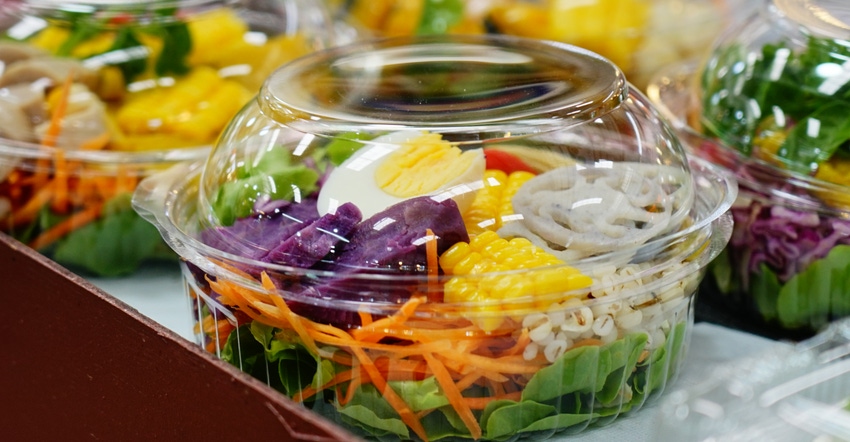Packaging sustainability “fit for use” assessments will depend on the type of food, the occasion, and the region where it is sold.

What we eat and how we dispose of what remains — the food scraps and packaging — have a significant impact on our environment. In the world of packaging innovation, considering the totality of a package’s use is referred to as “fitness” or “fit for use.” I often talk about a package’s fit for use and the importance to thoroughly consider this assessment when making recommendations to improve packaging sustainability.
The term “fit for use” has evolved. It once focused solely on the functional requirements of a package to perform by keeping food safe, fresh, and transportable throughout the various stages of the supply chain. In today’s sustainability driven society, the term has progressed beyond the package and the food. The modern economy puts pressure on a package’s sustainability not only to perform in food preservation, but also to take into account the environmental impact the package and food will have at the point of disposal.
What is packaging sustainability anyway? I like to think of packaging sustainability from the point of view of the environment and reframe the phrase to “packaging environmental responsibility.”
Packaging environmental responsibility is the series of decisions that can be made to improve the accountability of the package and the impact it has on its regional environment. Therefore, when starting a fit-for-use assessment, it is important to evaluate what will be packaged and how it will be disposed, not just the package itself.
“… when packaging manufacturers look for opportunities to improve packaging sustainability, improvements should not be made at the expense of food preservation.”
Food and beverage packaging differs from other categories because preservation is critical if not the most critical aspect to ensure food safety is executed faultlessly every time. Therefore, when packaging manufacturers look for opportunities to improve packaging sustainability, improvements should not be made at the expense of food preservation.
Packaging’s role in food waste reduction is important to sustainability initiatives on large scales. Consider the effort, energy, and resources that go into food production. Now throw the food into a landfill due to spoilage. This does not benefit the environment, regardless of how sustainable a package claims to be.
As packaging manufacturers begin to review opportunities to improve packaging’s environmental responsibility it should start with the food and end with an empty package. If all goes accordingly, consumers should enjoy a fresh meal or a snack and, when done, have a clear understanding of how to properly dispose of the empty package and any leftover food scrapes to minimize negative impacts to the environment. This comes in the form of unnecessary food or packaging waste.

Before we can design the perfect package, let’s take into consideration the types of food we need to package and how this will influence design and material choice.
The types of food we package matter.
The types of food you sell plays a major role in shaping the packaging you need. Different types of food have different packaging requirements to ensure the product stays fresh, safe, and appealing to consumers. Consider these five general food classification categories:
Perishable foods: Foods that are perishable — such as fruits, vegetables, and meats — need packaging that helps maintain their freshness and prevent spoilage. This often includes packaging materials that are breathable, to allow for the release of gases and moisture, or barrier packaging materials that are moisture-proof, to keep the food dry, or block oxygen from entering the package.
Processed foods: Processed foods — such as snacks, cereals, and canned goods — need packaging that helps preserve the food and extend its shelf life. This consists of packaging materials that are airtight, to keep the food fresh and protect it from moisture, light, and oxygen.
Frozen foods: Foods that are kept frozen — such as ice cream, frozen dinners, and frozen fruits and vegetables — need packaging that helps protect the food from freezer burn and keep it frozen. This involves packaging materials that are moisture-proof, to prevent ice crystals from forming and causing damage to the food over time.
Liquid foods: Liquid foods — such as soups, sauces, and drinks — need packaging that helps prevent leakage and contamination. This regularly incorporates packaging materials that have a tight-fitting lid to prevent leakage and spills, and packaging that can be either rigid or flexible depending on its application.
Pre-cooked foods: Pre-cooked or ready-to-eat foods — such as sandwiches or prepared entrées — need packaging that helps maintain the food's temperature, taste, and texture. This frequently means packaging materials that are insulated, to keep the food warm or cold, and with properties to maintain its texture during retail display.
In short, the type of food we sell shapes the packaging we need by determining the materials, design, and properties the packaging must have to maintain the food's quality, safety, and freshness.
But it’s not just the types of food we eat, it is how we eat our food that has such an influence on packaging choice and the footprint it leaves on the environment. Consumption trends play a significant role in influencing packaging choice.

The American diet influences packaging choice.
The American diet plays a significant role influencing packaging choice beyond its borders. The American diet is known for its high consumption of processed and convenience foods, which often comes in packaging that is designed to be convenient, easy to open, and able to preserve the food for long periods of time.
Some of the ways in which the American diet influences packaging choice include:
Convenience and portability: The American diet, which is heavily focused on convenience and on-the-go eating, has led to an increase in the demand for packaging that is easy to open and easy to transport. This has led to the development of packaging that is resealable, such as zipper bags, and packaging that is designed to be eaten straight from the container, such as single-serving cups and bowls.
Preservation: American eating habits, which are heavily focused on processed and packaged foods, has led to an increase in the demand for packaging that can preserve the food for long periods of time. This has led to the development of packaging that is airtight, such as vacuum-sealed bags, and packaging that is designed to block out light, such as metal cans.
Aesthetics: Like a lot of cultures, Americans eat with their eyes, and the American diet also plays a role in shaping the aesthetics of packaging. For example, many American food products are marketed with bright colors and bold designs, which has led to an increase in the use of vibrant and eye-catching packaging that makes printing a priority in packaging design.
Large portion sizes: The western diet often includes large portion sizes, which leads to packaging that needs to be larger and more durable, to withstand the weight and size of the food.
Fast food: The American diet is heavily influenced by fast food, and this has led to an increase in the demand for packaging that can withstand the high temperatures and handling of fast-food restaurants. This has led to the development of packaging that is oil-resistant and heat-resistant, such as paper cups and containers with clear plastic lids to aid order accuracy.

Consider global differences in food consumption, too.
The way packaging is influenced by diet may differ in other parts of the world due to cultural and economic factors. Some examples of how packaging may differ in other parts of the world include:
Asia: In many Asian countries, there is a strong emphasis on fresh, home-cooked meals. This has led to an increase in the use of packaging that is designed to keep food fresh and maintain its quality, such as breathable paper or mesh bags for produce, and vacuum-sealed bags for meats and seafood. Additionally, many Asian countries have adopted a strong emphasis on recycling and reducing waste, which has led to an increase in the use of recyclable and compostable packaging materials.
Europe: In Europe, there is a strong emphasis on environmental sustainability and reducing waste. This has led to an increase in the use of packaging that is designed to be reusable or compostable, such as multi-use plastic packaging or plant-based packaging. Additionally, many European countries have strict regulations on the use of certain chemicals, such as per- and polyfluoroalkyl substances (PFAS) used in food packaging, or single-use plastic bans, that has led to an increase in the use of alternative materials, such as paper or cellulose-based packaging free of intentionally added PFAS
Africa: In many African countries, there is a strong emphasis on local and traditional foods and bold flavors. This has led to an increase in the use of packaging that is designed to protect and preserve traditional foods, such as dried and fermented foods, which are often packaged in airtight containers, such as metal cans or glass jars.
Latin America: In Latin America, there is a strong emphasis on food culture and tradition. This has led to an increase in the use of packaging that is designed to reflect the cultural and traditional aspects of the food, such as using bright colors, bold designs, and traditional motifs on packaging. Additionally, many Latin American countries have a strong emphasis on recycling and reducing waste, which has led to an increase in the use of reusable and compostable packaging materials.
Overall, packaging decisions are influenced by the diet and culture of each region, which leads to variations in the materials, design, and sustainability attributes, depending on a package’s geographic service to its consumers. Additional performance attributes, or fit for use, puts an emphasis on freshness, preservation, safety, and the environmental responsibility of the package at the point of disposal.
To recap: The American diet and sheer global influence, plays a significant role in shaping the packaging industry by driving demand for packaging that is designed to be convenient, easy to open, able to preserve food for long periods of time, and to be eaten or served straight from the container. Worldwide, the focus on reusable materials, and recycling or composting disposal methods are growing trends. This puts pressure on global brands to consider a series of decisions that can be made to improve the accountability of the package and the impact it has on its regional environment.
With packaging sustainability on everyone’s radar, it is important to dissect what sustainability means to the food, the region, and the environment. Packaging manufacturers can start their assessment by understanding the types of food we are packaging and how dietary and cultural trends influence the responsibility the package will have to the regional environment when the meal is done, and the package is ready to be disposed. This will unlock the right choices in packaging design and materials, getting the package one step closer to perfection.
Additional Info/References:
1. Marshall, K., Ph.D, & Bugusu, B., Pd.d (2007). “Food Packaging—Roles, Materials, and Environmental Issues.” Journal of Food Science, 72(3), R39-R55. https://doi.org/10.1111/j.1750-3841.2007.00301.x
2. Ncube LK, Ude AU, Ogunmuyiwa EN, Zulkifli R, Beas IN. “Environmental Impact of Food Packaging Materials: A Review of Contemporary Development from Conventional Plastics to Polylactic Acid Based Materials.” Materials (Basel). 2020 Nov 6;13(21):4994. doi: 10.3390/ma13214994. PMID: 33171895; PMCID: PMC7664184.
3. Pauer E, Wohner B, Heinrich V, Tacker M. “Assessing the Environmental Sustainability of Food Packaging: An Extended Life Cycle Assessment including Packaging-Related Food Losses and Waste and Circularity Assessment.” Sustainability. 2019; 11(3):925. https://doi.org/10.3390/su11030925
4. Pardeshi, Ishvar. (2014). “Convenience Foods and Its Packaging Effects on Human Health-A Review.” Journal of Ready to Eat Food. 1. 127-132.
5. Gastón Ares, Ana Laura Velázquez, Leticia Vidal, María Rosa Curutchet, Paula Varela, (2022). “The role of food packaging on children’s diet: Insights for the design of comprehensive regulations to encourage healthier eating habits in childhood and beyond.” Food Quality and Preference, 95(104366), ISSN 0950-3293. https://doi.org/10.1016/j.foodqual.2021.104366
About the Author(s)
You May Also Like




